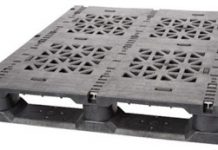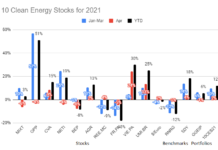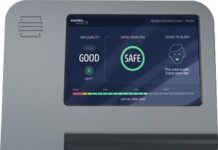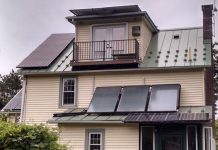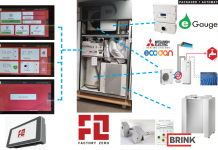Joel Makower
 If you start with the premise that many of the solutions to our global sustainability challenges require smart design and systems thinking, it doesn’t take long before you find your way to Autodesk (ADSK). The 29-year-old design software company has made a series of impressive moves into the sustainability realm over the past few years. It’s one of those largely unheralded companies creating the tools used by architects, designers, manufacturers, and most recently cleantech entrepreneurs to produce the next generation of greener, cleaner, more efficient products.
If you start with the premise that many of the solutions to our global sustainability challenges require smart design and systems thinking, it doesn’t take long before you find your way to Autodesk (ADSK). The 29-year-old design software company has made a series of impressive moves into the sustainability realm over the past few years. It’s one of those largely unheralded companies creating the tools used by architects, designers, manufacturers, and most recently cleantech entrepreneurs to produce the next generation of greener, cleaner, more efficient products.
Over the past year or so, I’ve had the opportunity to meet with or interview several members of Autodesk’s sustainability team as well as its CEO, Carl Bass, on a number of occasions. Along the way, I have become increasingly impressed with how the company hasn’t merely expanded its offerings to help design professionals achieve sustainability goals, but has also set out to elevate the sustainability knowledge and capabilities of design students and professionals, from high schoolers to seasoned engineers.
Autodesk makes a suite of 2D and 3D design software tools commonly known as CAD, for computer-aided design. Its flagship product, AutoCAD, along with the more advanced tools that integrate with AutoCAD, is the standard design software in architecture, engineering, and construction firms; manufacturing environments, such as industrial machinery, tool and die, automotive, and consumer products; and media and entertainment companies. (Autodesk software has been used in the special effects of dozens of movies, from “Alice in Wonderland” to “X-Men.”)
Starting a few years ago, as green building grew from the margins to the mainstream, Autodesk began integrating components to help architects, engineers, and designers perform “whole building” analysis, optimize energy efficiency, even aim for carbon neutrality. It developed Building Information Modeling, or BIM, software, which allows architects, engineers, construction professionals, facility managers, and owners to break down barriers and bridge communication between design and construction teams, with the goal of optimizing buildings and creating predictable outcomes. Autodesk began using its own facilities as a living laboratory to gain real-world experience. “The idea is to use our own operations as a testing ground for prototyping new products, new features, new workflows that would serve our customers and rapidly green, in this case, existing buildings,” Emma Stewart, senior program lead for the Autodesk Sustainability Initiative, told me.
No Green Button. Those efforts created a gateway into sustainability for Autodesk that has spread beyond buildings to designing everything from products to cities.
Sarah Krasley, a product manager in Autodesk’s Manufacturing Industry Group, works with the company’s industrial customers to help embed sustainability. “We have customers in building products,” she explains. “We have customers who are designing apparel. We have customers that are designing consumer packaged goods. The myriad of sustainable design objectives across those industries is vast, and we realize that there is no green button. That is, there’s not one simple sustainability tool that you can put into a CAD system and solve everybody’s problems. So we’re doing a lot of exploration at where sustainable design comes up in the workflow, and where it’s most meaningful.”
One outcome of that exploration was a partnership announced last fall with Granta Design, a developer of materials databases, that combines Autodesk’s Digital Prototyping technology with Granta’s materials information technology to enable industrial designers, mechanical engineers, and others to more easily create products through sustainable design.
At the other end of the spectrum is a partnership with CDP Cities, a project of the Carbon Disclosure Project, which has worked to standardize carbon reporting and risk management. Now CDP is working to do the same with municipalities, from Beijing to New York. Autodesk partnered with CDP to standardize the software platform for how cities are tracking, managing, and reducing their carbon risk over the next 40 years, explains Stewart. “So all of a sudden, Mayor Bloomberg and his team are able to look out at New York City and understand the resource flows of energy, waste, water in a way they’ve never done before, and map that against the way sea level will rise over the next 40 years, and then make financial decisions accordingly.”
Class Acts. The city-level partnership exemplifies one of the things I find most interesting about Autodesk: It invests in educating the marketplace, seeding future customers with free or low-cost versions of its software. This isn’t unique to the sustainability space, but sustainability may be where it’s needed most. To limit sustainable design to the relatively small population of engineers, designers, and architects who already “get it” misses a vast opportunity for both the company and the planet.
Autodesk has more than 1.5 million students in its Education Community, which allows students, both undergrads and grads, to download and test-drive free software and other tools. The idea is that students learn their craft using Autodesk software and, of course, want to use it in their professional lives, too.
Those students, it seems, hadn’t been learning much about sustainability in their studies. “The thing that kept coming up as we made new software innovations is that there are a lot of people who are not even familiar with the terminology around sustainable design, and are not familiar with how to take these high-level concepts and break them down into steps that are actionable,” Dawn Danby, Sustainable Design Program Manager at Autodesk, explains. “If we’re going to start building new solutions for doing all kinds of energy analysis or materials analysis, people need to understand why this stuff matters and have a context for it. We’re very aware that the hundreds of thousands of mechanical engineers every year who are being released into the marketplace are about to make very significant resource decisions.”
 In response, Danby and her team last year launched the Autodesk Sustainability Workshop, a series of free online instructional videos. They’re short, clever works, produced by Free Range Graphics, the team that created Annie Leonard’s wildly popular viral video, The Story of Stuff, and its growing spinoff projects. Danby herself stars in the segment on Whole Systems Design, with sustainability education guru Jeremy Faludi leading most of the others. It’s a terrific public service and a fun way to learn, even for us non-designer types. (Autodesk also spons
In response, Danby and her team last year launched the Autodesk Sustainability Workshop, a series of free online instructional videos. They’re short, clever works, produced by Free Range Graphics, the team that created Annie Leonard’s wildly popular viral video, The Story of Stuff, and its growing spinoff projects. Danby herself stars in the segment on Whole Systems Design, with sustainability education guru Jeremy Faludi leading most of the others. It’s a terrific public service and a fun way to learn, even for us non-designer types. (Autodesk also spons
ored AskNature.org, a free portal for architects, designers, and engineers on bio-inspired design, produced by the Biomimicry Institute, on whose board I sit.)
Seeding the Market. And then there’s the company’s Clean Tech Partner Program, which aims to pretty much give away suites of software about $50,000 worth to hundreds of cleantech start-ups. Entrepreneurs submit an application, explain what they’re doing, and get a complete suite of Autodesk software for a nominal fee. The program started two years ago in the U.S., then spread to Europe and, most recently, to Japan. Again, the idea is to seed these startups with Autodesk tools, with the hopes that they’ll become paying customers as they grow.
“In the short term, [sustainability] is the most pressing problem we face as a society, and I think it’s important that we do things to help solve the problem,” Autodesk CEO Carl Bass told me recently. “And I think a lot of the innovation is going to come from small companies.” Along the way, Bass has become a frequent speaker at cleantech conferences and an articulate advocate for cleantech entrepreneurs. (You can watch excerpts from an interview I did with Bass, below. I’ll be interviewing him again, onstage at the Green:Net 2011 conference in San Francisco, on April 21.)
As I said, much of these activities remain unheralded in the wider world of green business; Autodesk isn’t typically one of the companies that springs to mind when people name sustainability leaders. In some ways, that’s what I like most about Autodesk: a company that quietly is building the foundation for a sustainable future, creating tools and partnerships that are fundamentally changing the way things are designed and built. We may never see buildings or products that boast anything along the lines of “Autodesk Inside,” but in some respects, our sustainable future could well be labeled exactly that.
For more than 20 years, Joel Makower has been a well-respected voice on business, the environment, and the bottom line. He has been called “The guru of green business practices.” This article was first published on his blog, and is reprinted with permission.


